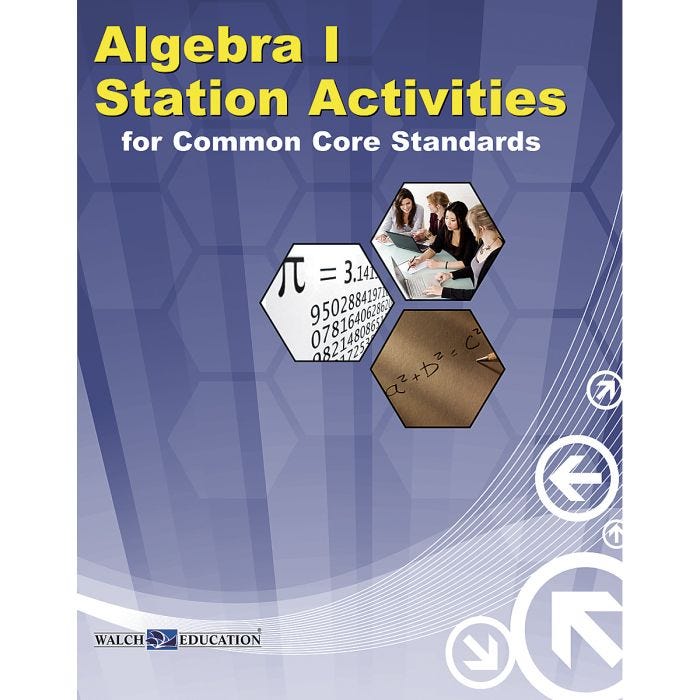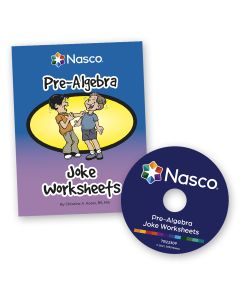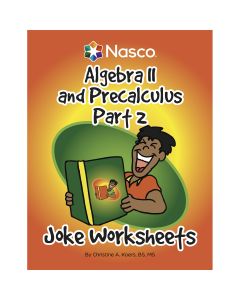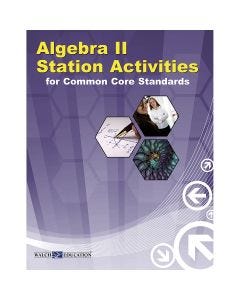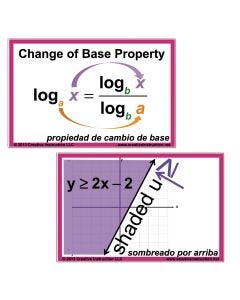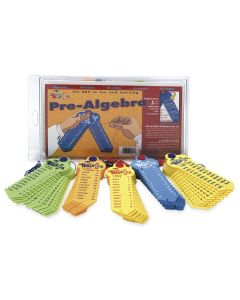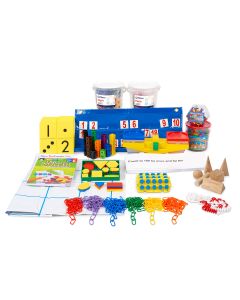Algebra I Station Activities for Common Core Standards
Grades 9-12. For your Common Core curriculum. These Common Core Standards supplements have been revised to tighten alignment and better reflect current interpretations of CCSS content and practices, based on implementation experience. Each book contains a collection of activity sets focusing on Number and Quantity, Algebra, Functions, and Statistics and Probability. Each activity set consists of 4 different stations (10-15 minutes each) where students work in small groups on multiple sets of activities, moving from station to station once their activities are complete. A debrief discussion follows the station activities. Uses readily available materials and manipulatives (not included). Includes teacher support with discussion guides, answer keys, and materials lists. 282 pages. HSN.Q.1 Use units as a way to understand problems and to guide the solution of multi-step problems, choose and interpret units consistently in formulas, choose and interpret the scale and the origin in graphs and data displays. HSN.VM.7 (+) Multiply matrices by scalars to produce new matrices, e.g., as when all of the payoffs in a game are doubled. Use the structure of an expression to identify ways to rewrite it. For example, see x4 - y4 as (x²)² - (y²)², thus recognizing it as a difference of squares that can be factored as (x² - y²)(x² + y²). HSA.SSE.3a Factor a quadratic expression to reveal the zeros of the function it defines. HSA.SSE.3b Complete the square in a quadratic expression to reveal the maximum or minimum value of the function it defines. HSA.SSE.3c Use the properties of exponents to transform expressions for exponential functions. For example the expression 1.15t can be rewritten as (1.151/12)12t ? 1.01212t to reveal the approximate equivalent monthly interest rate if the annual rate is 15%. HSA.APR.1 Understand that polynomials form a system analogous to the integers, namely, they are closed under the operations of addition, subtraction, and multiplication, add, subtract, and multiply polynomials. HSA.CED.1 Create equations and inequalities in one variable and use them to solve problems. Include equations arising from linear and quadratic functions, and simple rational and exponential functions. HSA.CED.2 Create equations in two or more variables to represent relationships between quantities, graph equations on coordinate axes with labels and scales. HSA.CED.3 Represent constraints by equations or inequalities, and by systems of equations and/or inequalities, and interpret solutions as viable or nonviable options in a modeling context. For example, represent inequalities describing nutritional and cost constraints on combinations of different foods. HSA.CED.4 Rearrange formulas to highlight a quantity of interest, using the same reasoning as in solving equations. For example, rearrange Ohm’s law V = IR to highlight resistance R. HSA.REI.3 Solve linear equations and inequalities in one variable, including equations with coefficients represented by letters. HSA.REI.4a Use the method of completing the square to transform any quadratic equation in x into an equation of the form (x - p)² = q that has the same solutions. Derive the quadratic formula from this form. HSA.REI.4b Solve quadratic equations by inspection (e.g., for x² = 49), taking square roots, completing the square, the quadratic formula and factoring, as appropriate to the initial form of the equation. Recognize when the quadratic formula gives complex solutions and write them as a ± bi for real numbers a and b. HSA.REI.5 Prove that, given a system of two equations in two variables, replacing one equation by the sum of that equation and a multiple of the other produces a system with the same solutions. HSA.REI.6 Solve systems of linear equations exactly and approximately (e.g., with graphs), focusing on pairs of linear equations in two variables. HSA.REI.10 Understand that the graph of an equation in two variables is the set of all its solutions plotted in the coordinate plane, often forming a curve (which could be a line). HSA.REI.12 Graph the solutions to a linear inequality in two variables as a half-plane (excluding the boundary in the case of a strict inequality), and graph the solution set to a system of linear inequalities in two variables as the intersection of the corresponding half-planes. HSF.IF.1 Understand that a function from one set (called the domain) to another set (called the range) assigns to each element of the domain exactly one element of the range. If ƒ is a function and x is an element of its domain, then ƒ(x) denotes the output of ƒ corresponding to the input x. The graph of ƒ is the graph of the equation y = ƒ(x). HSF.IF.2 Use function notation, evaluate functions for inputs in their domains, and interpret statements that use function notation in terms of a context. HSF.IF.7a Graph linear and quadratic functions and show intercepts, maxima, and minima. HSF.IF.7b Graph square root, cube root, and piecewise-defined functions, including step functions and absolute value functions. HSF.IF.7c Graph polynomial functions, identifying zeros when suitable factorizations are available, and showing end behavior. HSF.IF.7d (+) Graph rational functions, identifying zeros and asymptotes when suitable factorizations are available, and showing end behavior. HSF.IF.7e Graph exponential and logarithmic functions, showing intercepts and end behavior, and trigonometric functions, showing period, midline, and amplitude. HSF.BF.1a Determine an explicit expression, a recursive process, or steps for calculation from a context. HSF.BF.1b Combine standard function types using arithmetic operations. For example, build a function that models the temperature of a cooling body by adding a constant function to a decaying exponential, and relate these functions to the model. HSF.BF.1c (+) Compose functions. For example, if T(y) is the temperature in the atmosphere as a function of height, and h(t) is the height of a weather balloon as a function of time, then T(h(t)) is the temperature at the location of the weather balloon as a function of time. HSS.ID.1 Represent data with plots on the real number line (dot plots, histograms, and box plots). HSS.ID.2 Use statistics appropriate to the shape of the data distribution to compare center (median, mean) and spread (interquartile range, standard deviation) of two or more different data sets. HSS.ID.3 Interpret differences in shape, center, and spread in the context of the data sets, accounting for possible effects of extreme data points (outliers). HSS.ID.6a Fit a function to the data, use functions fitted to data to solve problems in the context of the data. Use given functions or choose a function suggested by the context. Emphasize linear, quadratic, and exponential models. HSS.ID.6b Informally assess the fit of a function by plotting and analyzing residuals. HSS.ID.6c Fit a linear function for a scatter plot that suggests a linear association. HSS.ID.7 Interpret the slope (rate of change) and the intercept (constant term) of a linear model in the context of the data. HSS.CP.1 Describe events as subsets of a sample space (the set of outcomes) using characteristics (or categories) of the outcomes, or as unions, intersections, or complements of other events ( HSS.CP.2 Understand that two events A and B are independent if the probability of A and B occurring together is the product of their probabilities, and use this characterization to determine if they are independent. HSS.CP.3 Understand the conditional probability of A given B as P(A and B)/P(B), and interpret independence of A and B as saying that the conditional probability of A given B is the same as the probability of A, and the conditional probability of B given A is the same as the probability of B.or,
and,
not
).
-
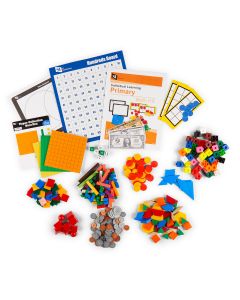 Primary Individual Learning Math KitProduct Number: NE30016In Stock
Primary Individual Learning Math KitProduct Number: NE30016In Stock -
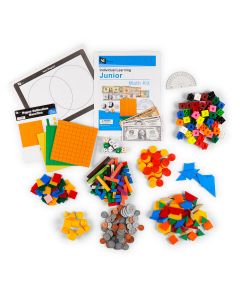 Junior Individual Learning Math KitProduct Number: NE30017In Stock
Junior Individual Learning Math KitProduct Number: NE30017In Stock -
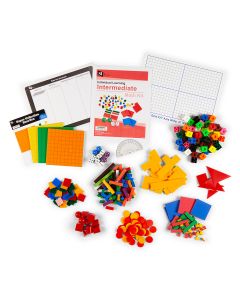 Intermediate Individual Learning Math KitProduct Number: NE30018In Stock
Intermediate Individual Learning Math KitProduct Number: NE30018In Stock -
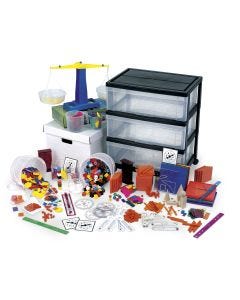 Nasco Intermediate Math Kit with StorageProduct Number: TB15923In Stock
Nasco Intermediate Math Kit with StorageProduct Number: TB15923In Stock -
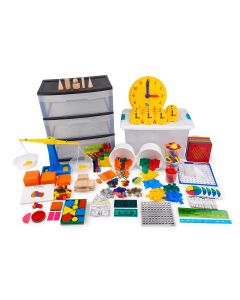 Nasco Primary Math Kit with StorageProduct Number: TB15924In Stock
Nasco Primary Math Kit with StorageProduct Number: TB15924In Stock -
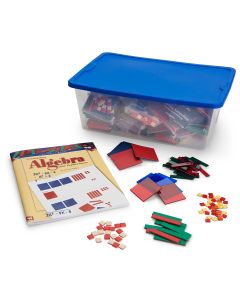 Nasco Algebra Tiles™ Classroom SetProduct Number: TB17249In Stock
Nasco Algebra Tiles™ Classroom SetProduct Number: TB17249In Stock -
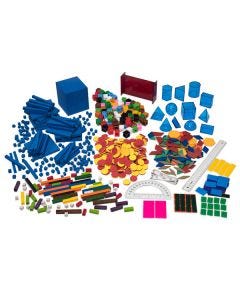 Math Methods Kit DProduct Number: TB26429In Stock
Math Methods Kit DProduct Number: TB26429In Stock







